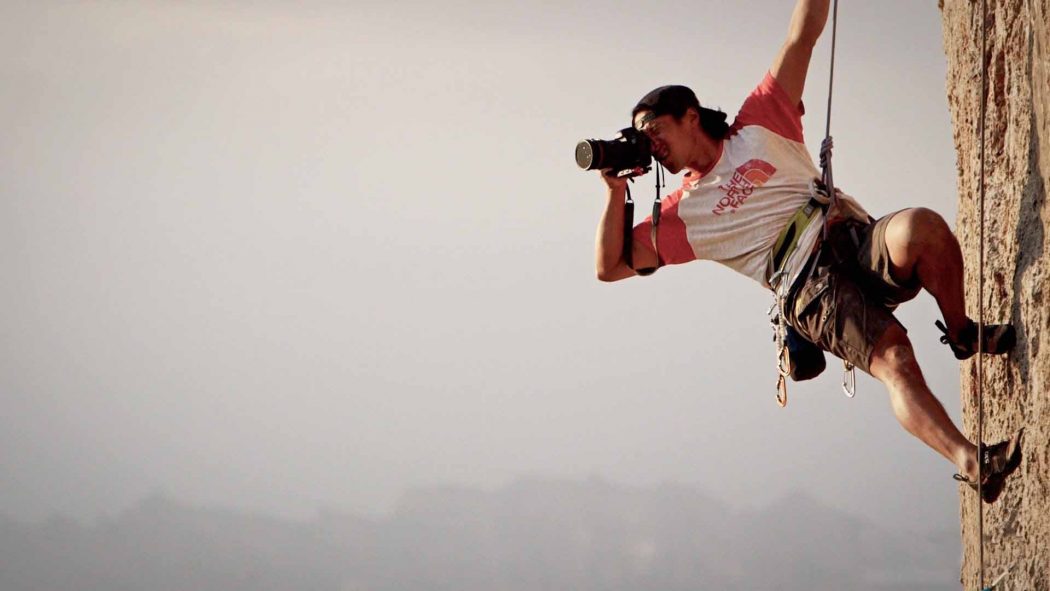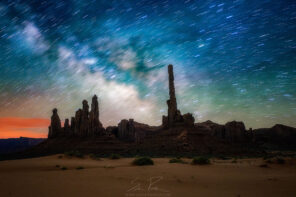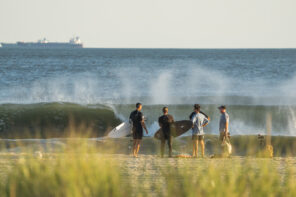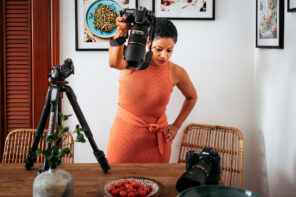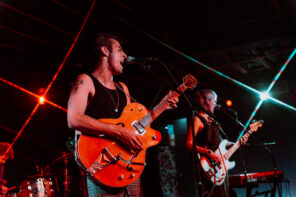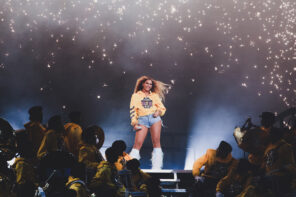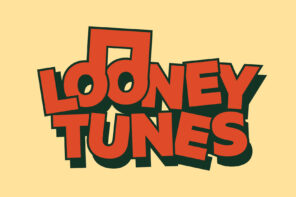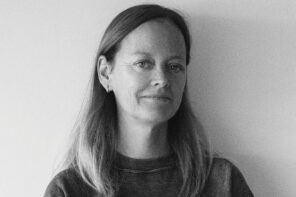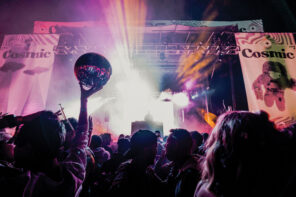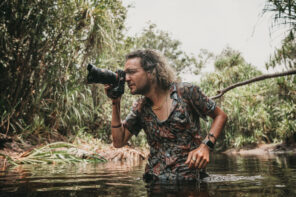Born the son of two Chinese immigrants, in a small rural Minnesota town, Jimmy Chin’s path to greatness seemed only possible as a fictional Hollywood movie plot. On paper, he should never have ended up where he is now, but he did… and in a big way. He’s a triple threat — an acclaimed filmmaker (director/producer of award winning documentary, Meru), renowned National Geographic photographer (with multiple NatGeo covers under his belt), and a world class North Face sponsored athlete.
When Whalebone asked me to interview someone, I thought about the current political landscape dominating our world lately, and the overuse of phrases like, “Make America Great Again.” I wanted to formally declare that America is great — and so I took the opportunity to interview Jimmy. To me, he represents every reason why our county is great.
Jon Rose: Excuse any weird, non-journal like tendencies, ’cause, I’m not a journalist. Where was your place of birth?
Jimmy Chin: Mankato, Minnesota.
JR: Mankato, Minnesota. Where’s that near?
JC: South central Minnesota, essentially the heartland of farming and cornfields. If you go outside of Mankato there are places you can look three hundred and sixty degrees and see just cornfields forever. It’s like one of the flattest places on the planet (laughs).
JR: So ironic that you ended up being a mountaineer (laughs).
JC: Yeah. I assume that it was my calling — because it’s just very unlikely that I’m doing what I’m doing on so many levels. Like, my parents are Chinese immigrants. There’s no such thing as like a mountaineering culture or climbing culture from where they’re from. And, it wasn’t anything that they were interested in me doing.
JR: So what would you call your profession now?
JC: That’s always hard to pin, but if I was going to break it down by like, my sources of income, it’s kind of like filmmaker, photographer, and athlete.
JR: Athlete.
JC: Climber. Yeah.
JR: Were you like a climber-athlete, outdoors-man, first? Or a photographer?
JC: I was a climber first. No, actually I was a skier first…I just loved being outside.
JR: Where do you see climbing in 20 years?
JC: I mean, it’s hard to say. It’s been interesting to watch it grow, and change, over the last 20 years. It used to be a fairly fringe activity — a lot of the culture comes from an anti-establishment, culture of people that lived in the outer rings of society. Living in Yosemite. Not getting real jobs, and just scraping their way around to being a climbing bum, or dirt bag. You know, in the climbing culture, [being called a] “dirt bag” is like a compliment.
JR: How can climbing culture be bigger, like, groundbreaking? What can they do?
JC: The thing that is interesting is that, again, parallel to surfing, it’s like, every generation thinks that they’ve maxed out what is possible, and then… somebody shows up and they’ll do something that is completely outrageous. The thing is, it’s because these kids show up, and their baseline is so high, because of everybody before them, and their like, “Well, why didn’t they do this?”. But every so often someone comes in and makes a quantum leap.
A photo posted by Jimmy Chin (@jimmy_chin) on
JR: Who are the main guys that you go on these epic missions with, like your crew?
JC: I have a list of mentors, like the people who I looked up to when I was starting, were people like, Peter Croft, Conrad Ankor, Alex Lowe, Mugs Stump. Then I’d go with this other guy, Greg Child. In terms of the photography and filmmaking world, it was Galen Rowell, David Breashears, I mean, they were kind of at the pinnacle of the film and photography world, in my space, in the climbing and outdoor kind of expedition world. In terms of expeditions that I’ve done a lot, in terms of people that I’ve done a lot of expeditions with, certainly Conrad Ankor is one of the guys I’ve done the most with. He’s a mentor, a friend and just a legend. I had posters of him when I was in college. Mark Synnott too, for sure.
JR: What do you think your greatest climb achievement is?
JC: One of the most outrageous trips I ever did was trying to climb the direct north face on Everest — alpine style. Which just means that there was no sharpest port, no fixed ropes, no fixed camps, no supplemental oxygen, ground up, and it just means that you’re pinning it.
JR: Pinning?
JC: Yeah. That’s like a “one hundred percent commitment.”
When I got caught in the avalanche in 2011 and I didn’t die, I came out of that experience thinking, “Wow, maybe things are — in a certain way — destined, because there’s no way that I should have lived, unless I wasn’t suppose to die that day.”
JR: You have had experiences that would undoubtedly be ultimate experiences in other people’s entire lives, and you are doing that as a fairly consistent lifestyle. Is it hard to live a sort of ordinary life when you come back home?
JC: Yeah. That’s a good question. You ever watch the movie, The Hurt Locker? Kathryn Bigelow’s film. The guys are coming back from the field, and people cannot relate with him. It’s not as extreme, I don’t think, because we are not shooting anybody, and nobody is trying to shoot us, but, there is a readjustment period, especially after a really heavy trip. It can be a little challenging to relate to other people and it might be challenging for other people to relate to where you are at. After you’ve done a lot of expeditions, that kind of eases up and you cannot really hide from normal life and reality. Well, maybe you can (laughs), maybe that’s what I’m still doing, but it can be challenging.
JR: Who’s your favorite photographer?
JC: I mean, I think the first person that I looked up to as a photographer was Galen Rowell, just because he kind of redefined what it meant to be like an adventurer, expedition photographer. He was a great athlete.
JR: What’s your take on social media?
JC: My social media is fairly constructed. In a way it’s an obligation, some days I’m totally inspired and stoked to post something, and some days it’s just a job. I think it’s really interesting what it’s done for the photography industry in that it’s democratized the photography industry. It’s a love-hate thing; “This is ridiculous, I hate this thing, it is stupid,” and then there’s like so many nice aspects to it, as well.
JR: What is Meru? I know it’s one of my favorite films you made about a first ascent and a climb called the Sharks Fin — the biggest, and marked the most unclimbable, in the Himalayas. Is that correct?
JC: Yeah. In the surfing world they would be equated with the way that everybody’s tried, but nobody has ever been able to ride an unrideable wave.
JR: It’s probably Jaws pre-paddle. And, nobody had ever gotten past halfway on it.
JC: I think this place had a notorious reputation because, by the numbers, it had seen more attempts and failures than any other in the Himalayas, and they were by pretty good teams. I think making the movie was one of the hardest things I’ve ever done. Like any endeavor in which you commit yourself to one hundred percent, and the outcome of being successful seems small, but you have to — you are driven to do it. It becomes this obsession, and you have to finance the film, so you have to convince other people that it is going to work, and just keep believing in yourself. The thing that kept propelling me was what I thought the film could say about friendship and mentorship. Then it got into Sundance and kind of sprung on to have another life after the film festival, and the theatrical release.
JR: Do you think everything happens for a reason, or are we the reason why things happen?
JC: It’s hard to look at my life in any other way but backwards, so when I look at the things that have happened, I always think, “wow, yeah, I really needed that experience too, and it played a real role in shaping who I am.” In a way I believe that everything does happen for a reason, for you to grow and move forward. “Do you believe in destiny,” is often a question that I get, or something that I ponder. When I got caught in the avalanche in 2011 and I didn’t die, I came out of that experience thinking, “Wow, maybe things are in a — certain way — destined, because there’s no way that I should have lived, unless I wasn’t suppose to die that day.”
JR: Yeah, for sure. One thing about yourself that no one would know?
JC: I play the violin. I started playing the violin when I was two and a half. That and I’m a black belt.
JR: I didn’t hear you, I didn’t hear you say that. You’re a black belt, too?
JC: Yeah, in Taekwondo. I think I was the youngest black belt in Minnesota when I got it, I was like fourteen, or thirteen.
JR: Something you would love to learn? For me it would be how to build a motorcycle. Or learn how to sail. That’s just something I’ve just never done, and I want to do it. What about you?
JC: Um, I guess cause it’s for Whalebone, I’ve still never gotten, like, fully barreled before. But I love surfing.
JR: So, we gotta get you barreled then. Last question is, for someone who has chosen to build a life and a profession around the things that you love, rather than taking a more traditional path that society lays out for you, what would you say to somebody who is at a crossroads on which path to take?
JC: I think the question is, “Are you willing to live the rest of your life with the idea that you didn’t try to do what you wanted to do?”
A photo posted by Jimmy Chin (@jimmy_chin) on
Follow Jimmy Chin to the highest points at the ends of the Earth, and hopefully to a few aquatic location that have barrels in the near future, via his Instagram and website. Thank you, Jon + Jimmy!

